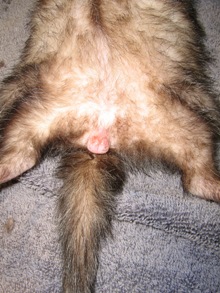Adrenal Disease Complex in Ferrets

Adrenal disease is one of the most common diseases of ferrets and can occur as early as 18 months old. In adrenal disease, the adrenal glands start to produce excessive sex hormones (both male and female sex hormones). These elevated sex hormones begin to cause problems for ferrets such as hair loss, itchy skin, pot -bellied appearance, loss of muscle tone, and lethargy. Some ferrets are intensely itchy. Females often develop a swollen vulva. Males may develop a swollen prostate gland causing difficulty urinating or causing him to have accidents outside the litter box. Female ferrets may develop and enlarged vulva. Some ferrets may show sexual behavior (mounting) or become aggressive. Some ferrets with adrenal disease can develop life-threatening drops in their red blood cells due changes in their bone marrow, and can be incurable if not caught in time. As the disease progresses the abdomen often becomes larger and ferrets become weak in their hind legs s the disease progresses the abdomen often becomes larger and ferrets become weak in their hind legs. If left untreated, adrenal gland disease is a life-shortening and life-threatening disease for ferrets.
One or both of the adrenal glands may become hyperplastic(over-active) or develop tumors. The majority of ferrets have hyperplasia or benign tumors. Less frequently, adrenal gland cancer can occur.
Ferret with a swollen vulva due to adrenal disease complex is shown here on the left.
Diagnosing Adrenal Disease
The clinical signs of hair loss, enlarged vulva, difficulty urinating (males), thin skin, and abdominal enlargement support a presumptive diagnosis of adrenal disease. Diagnostic blood tests including adrenal hormone analysis, complete blood count, and blood chemistries help diagnose adrenal disease and assess your ferret's overall health. An abdominal ultrasound to measure adrenal gland size provides confirmation of the diagnosis of adrenal disease and allows for monitoring of response to treatment (glands getting smaller). Additional tests may be needed based on your ferret's physical examination.
Treatment Of Adrenal Disease
MEDICAL OPTIONS
SURGERY

Why do ferrets get adrenal disease?
New drugs and treatment regimens are being explored across the country and we stay current with cutting edge information to offer you the best possible choices for your ferret's treatments.



